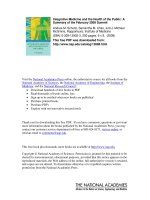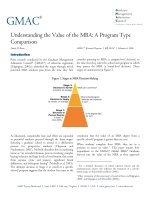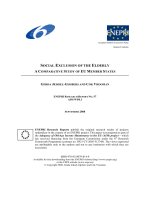Triumph of the fungi a rotten history
Bạn đang xem bản rút gọn của tài liệu. Xem và tải ngay bản đầy đủ của tài liệu tại đây (2.89 MB, 212 trang )
The Triumph of the Fungi
This page intentionally left blank
The Triumph of the Fungi
A Rotten History
NICHOLAS P. MONEY
2007
Oxford University Press, Inc., publishes works that further
Oxford University's objective of excellence
in research, scholarship, and education.
Oxford New York
Auckland Cape Town Dar es Salaam Hong Kong Karachi
Kuala Lumpur Madrid Melbourne Mexico City Nairobi
New Delhi Shanghai Taipei Toronto
With offices in
Argentina Austria Brazil Chile Czech Republic France Greece
Guatemala Hungary Italy Japan Poland Portugal Singapore
South Korea Switzerland Thailand Turkey Ukraine Vietnam
Copyright © 2007 by Oxford University Press, Inc.
Published by Oxford University Press, Inc.
198 Madison Avenue, New York, New York 10016
www.oup.com
Oxford is a registered trademark of Oxford University Press
All rights reserved. No part of this publication may be reproduced,
stored in a retrieval system, or transmitted, in any form or by any means,
electronic, mechanical, photocopying, recording, or otherwise,
without the prior permission of Oxford University Press.
Library of Congress Cataloging-in-Publication Data
Money, Nicholas P.
The triumph of the fungi: a rotten history/
Nicholas P. Money.
p. cm.
Includes index.
ISBN-13 978–0–19–518971–1
ISBN 0–19–518971–X
1. Fungal diseases of plants—History.
2. Fungi—History. I. Title.
SB733 .M59 2006
632′.4—dc22 2005037223
987654321
For Adam, my stepson
This page intentionally left blank
Preface
This book is concerned with the most devastating fungal diseases in history. These are the plagues of trees and crop
plants, caused by invisible spores that have reshaped entire landscapes and decimated human populations. Everyone is
aware of the Irish potato famine, but while many other fungal diseases are less familiar, they have had similarly
disastrous consequences. The Triumph of the Fungi focuses on the fascinating biology of the well-known and lesser-known
diseases. It also tells the stories of the scientists involved in their study and of the people directly affected by the loss of
forest trees including the chestnut, and cash crops such as coffee and cacao. Although a book about fungal epidemics
isn't tailor-made for an intoxicating and uplifting read, the chronicle of the mycologists and plant pathologists engaged
in combatting these diseases is one of human optimism (often encouraged by desperate eccentricity). In a surprisingly
brief time, human knowledge of the fungi that infect plants has evolved from Biblical superstition to the recognition of
the true nature of plant disease and, more recently, to a sense of awe for the sophistication of these organisms. The
crucial issue of human culpability in these fungal epidemics is addressed in the book's closing chapter.
A note about the title of the book seems appropriate. In the second year of World War II, the engineer, novelist, and
plant pathologist Ernest C. Large published a marvelous book, The Advance of the Fungi (New York: Henry Holt and
Company, 1940). Large introduced scientists to the study of plant diseases with a refreshing mixture of technical rigor
peppered with humorous asides. The Advance of the Fungi served as the introduction to fungal biology for many of the
plant pathologists that staffed university departments and government-funded laboratories throughout the second half
of the twentieth century. A second book, Mushrooms and Toadstools (London: Collins, 1953), published in 1953 by John
Ramsbottom, served
viii
as a similarly good-humored and inspiring source for mycologists. Ramsbottom's book served as a model (albeit
unconsciously) for my first book, Mr. Bloomfield's Orchard (New York: Oxford University Press, 2002). The focus of both
works, separated by a half-century of discoveries, was on topics such as fungal growth and mushroom function. In
similar fashion, The Triumph of the Fungi updates Large's classic by offering a personal view of the continuing advance of
the fungi in the last 65 years and by revisiting the history of the scientific study of plant disease.
I think that Large would approve of the new title. Since 1940, fungi have continued their advance, attacking every crop
plant that we cultivate, and exploiting new hosts wherever spores are introduced. Through their continued advance, the
fungi have proven unstoppable. Fungi are the most important cause of plant disease and cause billions of dollars of
crop losses every year. Despite fantastically effective fungicides, the continual development of resistant varieties of
crops, and the implementation of techniques of genetic modification, blights, rusts, and rots abound. After more than
a century of concerted scientific effort, epidemics like potato blight, chestnut blight, and Dutch elm disease remain
incurable. The best we can do is to continue the expensive fight to limit the negative consequences of fungal activity
throughout the biosphere. On a more positive note, biologists have been successful in documenting the essential
nature of our varied interactions with fungi. It is clear that we would find the planet uninhabitable without fungi.
The presentation of the epidemic diseases in The Triumph of the Fungi does not follow their historical appearance nor the
history of their recognition by humans. Instead, the book opens with the story of chestnut blight, the fungal disease
that reshaped the forests of the eastern United States in the twentieth century (chapter 1). It is difficult for us to
appreciate the overwhelming impact of this disease for the simple reason that few of us were born early enough to
have seen a giant American chestnut. (Incidentally, 2006 is the 100th anniversary of the first description of the blight
fungus.) Chapter 2 describes an equally destructive fungus that annihilated elm trees a few years after the appearance of
chestnut blight. More than any other fungal epidemic, Dutch elm disease has changed the appearance of villages,
towns, and cities in Europe and North America. Chapters 3, 4, and 5 address fungal epidemics of three tropical
commodity crops: coffee, cacao, and rubber. These diseases are united by the spread of plantation
ix
agriculture by European colonists in the nineteenth century, and they illustrate the extreme vulnerability of
monoculture agriculture to fungal attack. The origins of the scientific study of plant diseases are addressed in chapters
6 and 7, beginning with the attempted placation of the Roman mildew god, to seventeenth-century experiments on
plant diseases and the eventual development of the branch of science called plant pathology. The diseases that were
responsible for the birth of plant pathology were the smuts and rusts of cereal crops (chapter 6) and the potato blight
pathogen that caused the Irish famine (chapter 7). The final chapter (chapter 8) explores the future of the ongoing
competition between humans and fungi for control of the biosphere. The fossil record shows that fungi have lived in
intimate associations with plants for the last 400 million years. Although many of the earliest fungi engaged in mutually
supportive relationships with land plants, others were probably attacking plants in the Silurian mud in much the same
way pathogens do today. But although there may be nothing truly novel about emerging epidemic diseases such as
sudden oak death, this perspective does little to alleviate concern about the future health of forests or the effects of
fungi on agriculture. I hope that you'll enjoy my take on the stories in this book as much as I have relished delving into
this rich archive of microbiology.
This page intentionally left blank
Acknowledgments
The only formal course in plant pathology that I took as a college student was taught by Julie Flood at the University
of Bristol. This was, I recall, a fantastic class and Julie bears no responsibility for any deficits in my understanding of
plant pathology. Many of my other tutors—including Marshall Ward, Anton de Bary, and Miles Berkeley—are long
dead, leaving me to comb through their dusty writings in Cincinnati's incomparable Lloyd Library. This book would
not have been possible without the Lloyd collection, and my sincere thanks go to Maggie Heran and the staff at the
library for leading me through the last four centuries of plant pathology literature. A rare gap in the Lloyd's collection
was filled by the American Museum of Natural History in New York City, whose librarian, Ingrid Lennon, was helpful
in locating a particularly obscure journal article. I am grateful to my colleagues Holger Deising (Martin-LutherUniversity Halle-Wittenberg), Sophien Kamoun (The Ohio State University), and David Rizzo (University of
California) who furnished illustrations. Mike Vincent, curator of the Willard Sherman Turrell Herbarium at Miami
University, answered many questions and found the lovely drawing of the elm bark beetle used in chapter 2. Carolyn
Keiffer, also at Miami University, shared her expertise as a chestnut blight researcher and accompanied me on a
harrowing flight in a small plane to Wisconsin so that I could see surviving trees. Finally, I thank my editors, Diana
Davis and Peter Prescott, and an anonymous reviewer who was responsible for the removal of some of my more
irresponsible asides.
This page intentionally left blank
Contents
1 Landscape Architect
2 A Farewell to Elms
3 The Decaffeinator
4 Chocaholic Mushroom
5 Rubber Eraser
6 Cereal Killers
7 Potato Soup
8 Blights, Rusts, and Rots Never Sleep: A Look at Forestry and Agriculture,
Biological Warfare, and the Global Impact of Fungal Disease
Notes
Index
CHAPTER
CHAPTER
CHAPTER
CHAPTER
CHAPTER
CHAPTER
CHAPTER
CHAPTER
1
25
45
65
83
101
119
137
161
191
This page intentionally left blank
CHAPTER 1
Landscape Architect
The tiniest wound, just a nick in the bark; spores drift in from the moist forest air; later, the stem swells and ruptures;
the sap-flow system is crippled, and leaves are shed. Bereft of its plumbing and solar panels, the crown of the gigantic,
alabaster ghost sways brittle in the breeze. When this story was repeated 3 billion times, a tree that had dominated the
eastern woods of North America for more than 50,000 years was exterminated. This is what happened to the
American chestnut, Castanea dentata (fig. 1.1), when it met the landscape architect called chestnut blight.
The beginning of the end for the American chestnut is usually tracked to a report by Hermann W. Merkel, a forester
who discovered dying trees at the Bronx Zoo in the summer of 1904. Foliage was wilting on diseased branches whose
bark revealed telltale bands of infected tissue. Merkel said that the disease was limited to “a few scattered cases” in
1904, but by the next summer the blight had spread. Chestnuts of all sizes showed the same symptoms: the disease had
escaped from the zoo. Merkel estimated that 98 percent of Bronx chestnuts were infected. The chestnuts grew in parks
throughout the borough and lined avenues just as they graced and shaded cities across the country. Merkel requested
$2,000 to engage a crew to prune and burn diseased branches from trees in the zoo. This seemed like a good defense:
gardeners often succeed in keeping fruit trees productive by trimming their scabbed limbs. He also purchased a powerspraying machine with a 150-gallon tank for $175 from the Niagara Gas Spraying Company and doused trees with a
“potato strength” (strong) solution of copper sulfate and lime (fig. 1.2). This compound, called the “Bordeaux
mixture,” was originally used to control grape mildew and had become the front line fungicide of proven effectiveness
against diseases of fruit trees
2
Landscape Architect
Fig. 1.1 Leaves and fruit of American chestnut, Castanea dentata. From F. A. Michaux, The North American Sylva; or, A
Description of the Forest Trees of the United States, Canada, and Nova Scotia. Considered Particularly With Respect to their Use in the
Arts and their Introduction into Commerce. To Which is Added A Description of the European Forest Trees. English translation, vol.
3 (Philadelphia: D. Rice and A. N. Hart, 1857).
and a variety of crops. The task was monumental. Three men operating the sprayer could treat no more than four
mature trees in a day, exhausting an entire tank of fungicide, and there were hundreds of chestnuts on the grounds of
the zoo. Merkel's team managed to prune the diseased branches from more than 400 specimens, carving some of the
trees down to nothing but a bare trunk. But despite these efforts, Merkel was realistic about the likely outcome: “Just
how far we have checked the progress of the disease is a matter of conjecture until the growing season reveals the
facts. Considering, however, the ease with which the spores may be transferred by the action of the wind or by
squirrels, birds, and insects … it is much to be feared that no permanent results will be achieved except by concerted
action on the part of all of the Park authorities in this Borough.”1
Merkel was amazed by the virulence of the blight. Branches of a tree that showed wilting symptoms on one day were
often dead within three weeks. Trees whitened from their crowns to the ground in a single season. Massive
Landscape Architect
3
Fig. 1.2 Spraying an infected American chestnut tree in the New York Zoological Garden in 1905. From H. W.
Merkel, Annual Report of the New York Zoological Society 10, 97–103 (1905).
specimens were debilitated as if struck by lightning. The disease was new to science.
Enter Dr. William Alfonso Murrill, a mycologist who had just been hired as an assistant curator at the New York
Botanical Garden that straddles the Bronx River immediately north of the zoo. Merkel had sent samples of the
diseased branches to the United States Department of Agriculture in Washington, D.C., appealing for information.
Discouraged by the lack of interest among the government plant pathologists, and witnessing the number of infected
trees skyrocket, Merkel visited Murrill in the summer of 1905. The 35-year-old mycologist immediately went to the zoo
and began collecting specimens of affected tissues. The appearance of the blight in his neighborhood, coupled with the
apathy of the USDA scientists, afforded Murrill a fantastic professional opportunity. Forty years later, in his
autobiography, he wrote that the USDA scientists had never forgiven “the ‘young upstart’
4
Landscape Architect
for beating them to it.”2 In 1906 he published a pair of classics in the literature of plant pathology, describing the
fungus that was responsible for this new disease, later called chestnut blight.3 Murrill also reported the sad news that
the disease had been identified in New Jersey, Maryland, the District of Columbia (visible from the office windows of
the USDA scientists), and Virginia. Others had reported blight in Alabama and Georgia. Because all of these outbreaks
occurred less than a year after its appearance at the zoo, the zoo couldn't have acted as the original source—no fungal
disease could spread that fast. The origins of the developing catastrophe were a mystery.
In his scientific papers, Murrill drew the spore-producing structures of the fungus and reasoned that trees were
probably infected through wounds in the bark, or through the natural breathing holes called lenticels. He also isolated a
fungus from infected chestnuts and grew it on agar in glass tubes. To test whether he had found the cause of the blight,
he then used the cultures to deliberately infect saplings in a greenhouse. Sure enough, the trees showed the familiar
disease symptoms and began shedding a new crop of infectious spores four to six weeks after infection. The scope of
his initial work was impressive. He recognized that spraying Bordeaux mixture was useless against a microorganism
hidden inside the bark, and therefore any effective disease treatment would need to be preventive. Finally, he named
the fungus: Diaporthe parasitica sp. nov. (sp. nov. for species nova or new species), which was later changed to Endothia
parasitica and is now known as Cryphonectria parastica (fig. 1.3). (I use the modern name for the rest of this chapter.)
Cryphonectria parasitica belongs to a group of fungal pathogens that cause a variety of diseases including cankers of
soybeans and peach trees, stem-end rot of citrus fruits, bitter rot of grape, and dogwood anthracnose. Related fungi
produce toxins inside plant tissues that poison farm animals. Goats develop a disease called lupinosis after consuming
toxin-containing moldy lupins, which is characterized by symptoms of heavy breathing and depression (how is this
manifested in a goat?), followed by the animal's lapse into a state described as “comatose with snoring,” all according
to the website www.goatwisdom.com.
By 1908 the disease had caused millions of dollars of damage to trees in New York City, leading Murrill to conclude
that there were no effective treatments.4 Even the kind of careful pruning tried by his colleague Merkel
Landscape Architect
5
Fig. 1.3 Slimy tendrils of conidia (asexual spores) extruding from pustules of the chestnut blight fungus, Cryphonectria
parasitica. From W. A. Murrill, Journal of the New York Botanical Garden 7, 143–153 (1906).
was useless. Reports of diseased trees arrived from all along the eastern seaboard, and another chestnut species called
the chinquapin (Castanea pumila) was also falling prey to the blight. Merkel suggested that diseased trees be cut as soon
as possible so that their lumber could be salvaged before further decay.5
American chestnuts once grew to an enormous size. In the southern part of their range, the trees reached a height of
24–37 meters (80–120 feet) while swelling to a diameter of 1.5 meters. They had been called the “redwoods of the
East.” Exceptional specimens of the tree measured in the nineteenth century exceeded a circumference of 10 meters.6
Though photographs show people dwarfed by the magnificent trees, chestnuts never came close to competing with
Californian coastal redwoods that can tower more than 110 meters. But nothing grew taller than Castanea dentata from
Maine to Alabama in a 500-kilometer-wide diagonal of deciduous jungle spined by the Appalachians. The impact of
the near extinction of the tree can be assessed, of course, from many perspectives. Chestnuts served as a staple
construction material for American pioneers. The timber is very rot resistant (which is ironic given the species'
vulnerability to fungal destruction), so cabins were assembled from trimmed logs and roofed with chestnut shingles.
Thousands of miles of fencing were
6
Landscape Architect
erected from chestnuts, the wood was used for railroad ties, and, closer to the end of the chestnut's history, it was used
for telegraph and telephone poles. Chestnut was also used for furniture and “buryin' boxes.”7 In the old-growth
forests, chestnuts may have accounted for one in four of the big trees. After the near-total deforestation of many of
the eastern states by the close of the nineteenth century, chestnuts may have become even more plentiful. This is
because the tree grows very swiftly, and it outcompeted other hardwoods in the areas where forests were allowed to
regenerate.8 There were billions of chestnuts before the European invasion, and there were billions, albeit younger
ones, after the wave of humanity had swept from coast to coast.
Besides the value of the wood, chestnut bark was essential for tanning leather. Like the production of toilet paper,
tanning is one of those easily-ignored but crucial human activities. Animal skin must be tanned before it can be turned
into shoes, belts, jackets, underwear for British aristocrats, and upholstery. Once the hide has been flayed from an
animal, it will decay quite quickly if it isn't dried, and when dried will be of little use as a motorcycle jacket unless the
biker wants to look like a sandwich board. But if the skin is treated with tannins in tree bark to modify its collagen
fibers, it becomes pliable and the fabric can be cut and sewn into something usable. Tannins are complex molecules
found in plant tissues that, among other activities, bind tightly to proteins. The color of tea is derived from the tannins
extracted by steeping the leaves in hot water. There are lots of tannins in chestnut bark, which is why the tree was
harvested to meet the demands of the leather industry. Hemlock trees were the preferred source of tannins, but the
rapid decimation of groves of this conifer in the nineteenth century led to the increasing use of chestnut. Thanks to the
blight, tanneries were gifted hundreds of thousands of tonnes of tannins in the 1930s, but that was the end of tanning
with chestnut in the United States.9
As everyone knows, chestnut seeds are roasted in great numbers on open fires as Santa Claus performs his annual
miracle. Most chestnuts sold by today's street vendors come from Europe, though nuts from hybrid trees are also
marketed by specialty growers in the United States, including Demarvelous Farms in Delaware. The disappearance of
nuts in the forests had a tremendous impact on wildlife. Chestnuts had offered a large crop every year that fattened
wild turkeys, deer, squirrels, black bears, and other animals. Acorns replaced the chestnuts after the blight, but fruiting
in oaks is subject to annual variation, which leaves animals up the proverbial creek
Landscape Architect
7
on a regular basis. Overall, one can say with some justification that the chestnut blight wasn't a good thing for North
America. That was one of the conclusions reached by delegates at a conference on the disease called by the Governor
of Pennsylvania in 1912.10
In 1911, the Pennsylvania legislature had appropriated $275,000 ($5.2 million adjusted for a century of inflation) for
analysis of the extent of the blight and to determine the most effective control method. The money was administered
by the Chestnut Tree Blight Commission, whose office was set up, with some irony, in a building at the intersection of
Broad and Chestnut streets in Philadelphia. Treatment of the blight was a serious political issue. Before the arrival of
the fungus, the value of the chestnut in Pennsylvania was estimated at $70 million, which is equivalent to $1.3 billion in
today's money.11 Having dealt with New Jersey, the chestnut fungus had already infected trees in eastern counties of
Pennsylvania and was racing westward across the Appalachians.12 The epidemic hadn't touched the woodlands of
Ohio, West Virginia, North Carolina, and all points west, but anyone who had seen the forests farther east was
worried.
The conference marked a triumph of emotion over science, beginning with a call to arms by John K. Tener, governor
of Pennsylvania: “The time to act is now, and not after the scientific world has more fully worked out the history and
pathology of the disease.”13 USDA scientists spoke about the nature of the pathogen, how it reproduced and how its
spores were spread; others talked about the origins of the disease and how it might be controlled. So far so good. But a
paper offered by Harvard botanist William Farlow allowed others to ignore the gloomy, but rational outlook of those
who best understood the disease. Farlow disputed Murrill's description of the new species, saying that the fungus had
been recognized in Europe for 50 years where it grew on a variety of trees and caused no damage. Murrill attended the
conference, but his opinion of Farlow's work was not recorded by the stenographer. (With a century of hindsight it is
clear that Murrill's work and conclusions about the blight were flawless.) Other respected scientists made significant
blunders. The plant pathologist George Clinton said that the fungus was a native American species whose proliferation
was caused by weather conditions. He also thought that the blight would decline naturally if the diseased trees were left
alone.
The majority of the delegates thought that the disease could be controlled. Merkel, the Bronx forester who discovered
the disease, was a
8
Landscape Architect
celebrity at the conference and commented that his “fondness for trees in general is the only reason that brought me
here; but that I should be pushed into the limelight thus—a modest violet like I am—was not my intention.” He
supported the commission's strategy of cutting infected and healthy trees in a wide belt to create a disease-free barrier
that would halt the fungus: “Sometime [sic] ago I wrote that only when we considered a tree that is dangerously
infected with an insect or a fungous pest as dangerous as a person infected with smallpox or as a rabid dog, will we get
rid in our forests of insect and fungous pests.”14
Murrill disagreed. Having been first to identify the pathogen and understand how it was disseminated, he recognized
the probable futility of creating a chestnut-free barrier to starve the fungus in the Appalachians. Fred Stewart from the
New York Agricultural Station concurred and stood out as one of the strongest voices of reason at the conference:
“My views are so much at variance with what I conceive to be the sentiment of this Conference that I hesitated
somewhat to present them. I feel like one throwing water on a fire which his friends are diligently striving to kindle.”15
Stewart contended that the Blight Commission was “rushing into this enormously expensive campaign against the
chestnut bark disease without considering as carefully as we should the chances of success.” A field test conducted in
Washington, D.C., in which a wide belt of diseased trees had been removed, suggested that movement of the fungus
might at least be slowed, but Stewart argued that without a controlled experiment there was slight reason for optimism.
Stewart's talk was followed by a profound silence. Pennsylvania's Deputy Commissioner of Forestry, I. C. Williams,
went further, saying that the state had “thrown two hundred and seventy-five thousand dollars into a rathole.” But the
optimists held the day. Stewart and other critics were ridiculed: “It has been suggested that we should do nothing to
counteract the ravages of the chestnut tree disease because we are not fully informed as to how to proceed. That is unAmerican. It is not the spirit of the Keystone State, nor the Empire State, nor the New England States,” and on and on
waxed a former Commissioner of Agriculture for New York State.16
The Blight Commission engaged a force of up to 200 men who would scout western Pennsylvania for diseased trees.
They were given the authority to destroy trees on private property even if the owner refused to cooperate. Had the
policy of eradication continued, this would have led to some
Landscape Architect
9
interesting legal challenges to the commission's work on the basis of the constitutional rights of landowners. At the end
of the year, the commission reported that there was still hope and discussed the value of pumping formaldehyde into
diseased trees.17 The commission was also enthusiastic about a contraption called the Fitzhenny-Guptill machine that
looked like a brewery on wheels. This appliance was drawn into the woods and used to drench trees with the fungicidal
Bordeaux mixture. People continued to believe that a spray would magically cure the blight. The public's gullibility and
concern about the disease were exploited by bogus tree surgeons who injected colored solutions into trees and spread
secret remedies on the soil,18 which recalls the contemporary fraud associated with the remediation of indoor mold
problems.
In July 1913, Governor Tener vetoed a bill appropriating money for the continuing work of the Blight Commission.19
The enormity of the cost, coupled with growing recognition that the blight would spread with or without the program
of eradicating diseased trees, led Pennsylvania to surrender to Cryphonectria. The victorious microbe slipped across the
Ohio border and within a few decades had colonized the entire natural range of the American chestnut. John Holmes,
State Forester for North Carolina, mourned the loss of chestnuts throughout the Appalachians, referring to the blight
as “not only a State but a National calamity.”20
Within two years of the appearance of chestnut blight in the Bronx, William Murrill had succeeded in unraveling the
major steps in the pathogen's life cycle. It was always possible that a clear picture of the way the fungus reproduced
and spread would lead to an effective approach to controlling the disease. The fact that chestnut blight has, even after a
century, outwitted everyone doesn't diminish Murrill's accomplishments. Here's how Cryphonectria parastica works. Once
the spores of the fungus enter a fissure in the bark, they germinate and form the characteristic branching colonies of
filamentous hyphae called mycelia. In chestnut blight, the mycelium develops as a dense white web that fans out
through the plant's bark and the tissues immediately beneath.
A brief lesson in plant anatomy will help explain how the fungus kills the tree. A tree is composed of a series of
concentric cylinders (fig. 1.4).
10
Landscape Architect
Fig. 1.4 Diagram showing the arrangement of tissues in a tree trunk. From R. A. Ennos, Trees (Washington, DC:
Smithsonian Institution Press, 2001), with permission.
Wood occupies the interior of the tree and accounts for almost all of the trunk's bulk. The central part of this tissue is
called the heartwood. The heartwood doesn't conduct water any longer; it used to, and the annual rings tell us when,
but it was replaced by younger and younger wood that develops on the outside. The younger wood is called sapwood.
Water and dissolved minerals are pulled up through pipes in the sapwood, called xylem vessels, that run all the way
from the roots to the leaves. The sapwood is surrounded by a thin cylinder of critical cells called the cambium. This is
the tissue that produces a new ring of wood every year from its inner surface. The cambium also generates the phloem,
which is the second type of conductive tissue that forms a cylinder on the outside of the cambium. The phloem
transports dissolved sugars in the opposite direction from the xylem. Sugars are produced in the leaves by
photosynthesis, and must be moved downward so that all of the tissues in the rest of the plant are fed. Finally, the bark
forms the outermost cylinder of tissue pressed onto the









